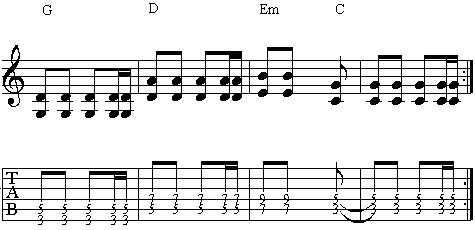Power chords are really any chords that sound good and heavy with a lot of distortion. Most of the time
they only include the 1st and 5th notes of the chords key scale. Power chords can be heard in a lot of different
musical styles including rock, punk, thrash etc. This lesson will teach you the fundamental power chord shapes, it's up to you
how you use them!
When you use power chords, you only have to be familiar with 2 things, the power chord shape and the string it is based off of. The root 6 power chord shapes
shown below are based on the 6th string notes. To know where you are at (which chord you are playing), just learn the names of the notes on the 6th string.
When you make the shapes below, just associate the name of the 6th string note your first finger is on to the chord. If your 1st finger is at the 3rd fret, it's a G - 5th fret, it's A etc.
Root 6 Power Chord Forms

Names of the 6th String Notes


Root 5 Power Chord Forms
The same is true for the root 5 power chords, only they are based off the 5th string.

Names of the 5th String Notes



Practice making the shapes and moving them around the fretboard.
This is otherwise known as the 2-string chord form.
Guitarists use the term "Power Chord" loosely. Since it takes 3 notes (in their simplest form)
to make a chord, technically, these are
not even chords. They have been used so much, and because of their "heavy" nature,
have been considered chords by guitarists.
This is not a complete power chord reference chart and there are many chords that are
classified by some as power chords. There are also many alternate tuning forms but since this ebook
only deals with standard tuning, I thought I would stick to the ones that are
considered by all to be power chords.
Here are a couple of exercises. The last one is kind of a "power riff" in dropped-D tuning.
A riff is the same as a "hook" - the main part(s) that you hear over and over in a lot of songs.
Power Chord Exercise 1
This one is a simple progression using the standard 2-string or "rock" chord form.

Power Chord Exercise 2
This progression uses the 3-note power chord form. These chords have a lower octave
5th in them. Theory: In a C Power Chord (3-string type), the 5th is the fifth
note in the chord's parent scale. So, the C power chord would have two G notes in it.
One, an octave higher and the other, an octave lower than the root note (C).
Use all downstrokes on this one.

Power Chord Exercise 3
I know I said we weren't going to deal with any altered tunings but you can't
discuss power chords without throwing something like this in because it's so heavy sounding.
To play in dropped-D tuning, tune your low-E string (6th) to a
low D note (it should sound the same as your 4th string only an octave lower). The chord form is made by using one finger across all three strings.

|

